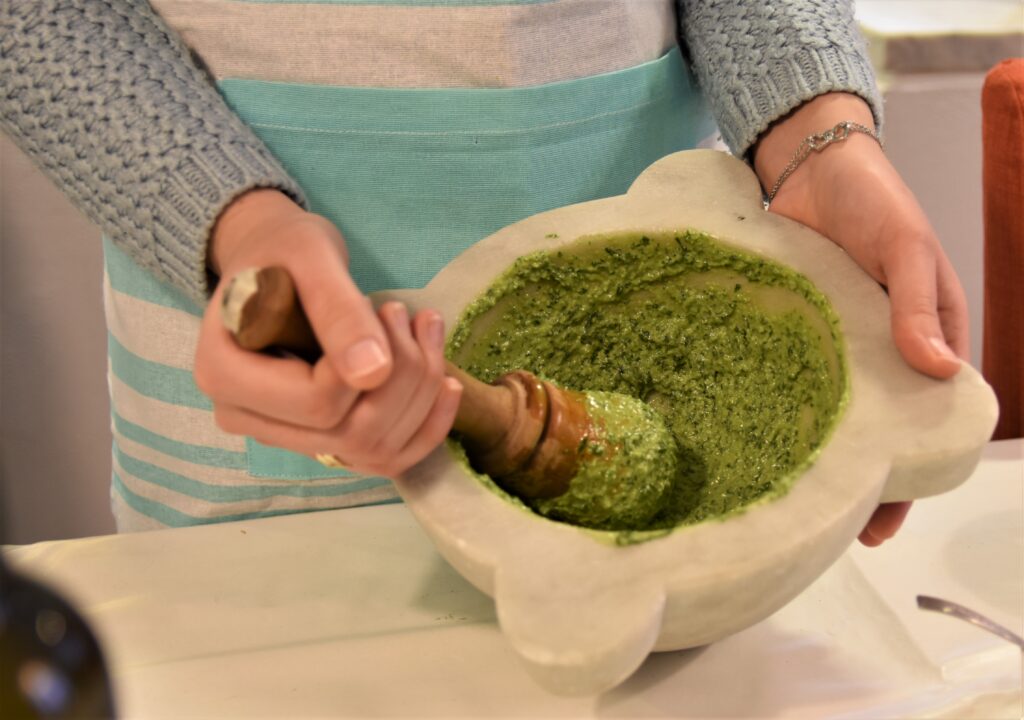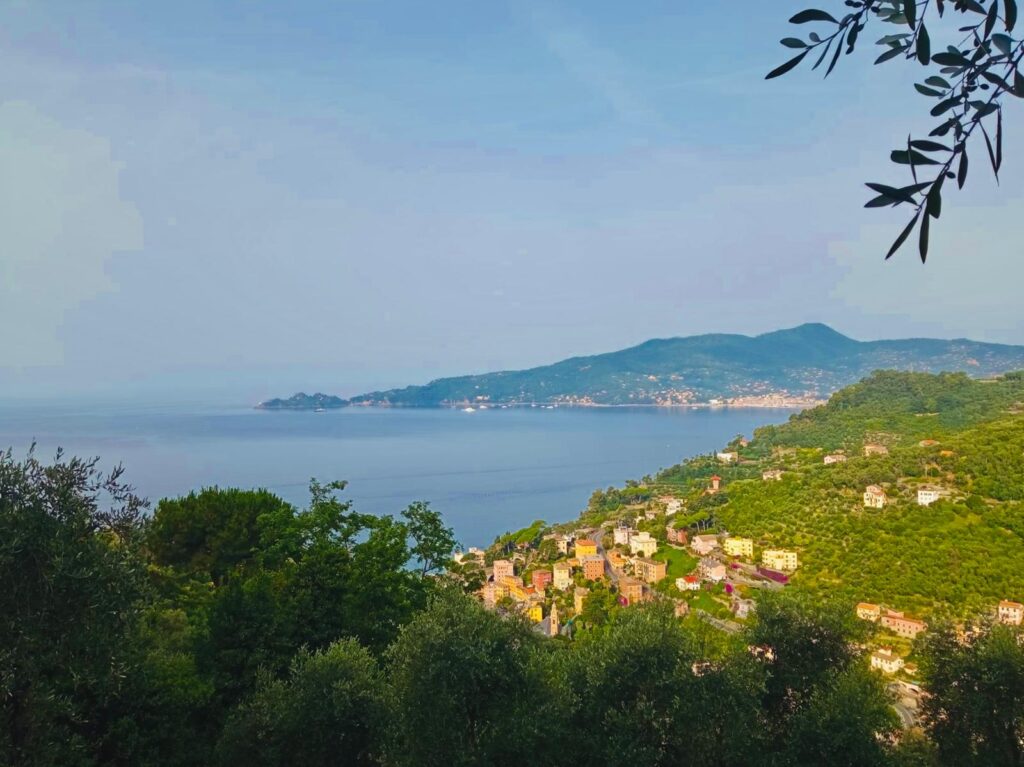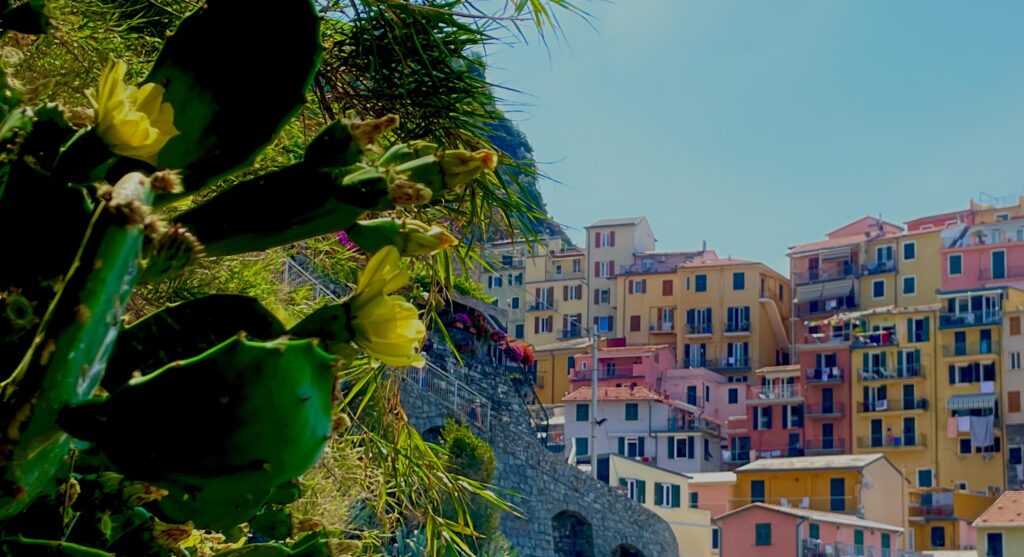If we want to talk about food in Liguria and Genoa in particular, just say pesto and there is no need for anything else.
It is the second best-known sauce in the world after tomato sauce, as well as the undisputed symbol of Ligurian cuisine.
Simple and tasty, it can easily be adapted to a thousand uses, according to the needs and habits of those who prepare it.
For the Ligurians, pesto is a life companion that one learns to appreciate from childhood, in pasta dishes or vegetable soup: something that remains forever imprinted in the olfactory memory as an original food.
Almost a sort of maternal food that cannot be ignored. It is an integral part of the Ligurian identity, practically an irreplaceable piece of DNA.
And it is also an untouchable topic, on which a Ligurian is not willing to compromise: pesto as it is made in Genoa cannot be found anywhere else!
If you are a descendant of Genoese and live in a place where it is difficult to find the ingredients required by the recipe, we give you a piece of advice: if you invite a Ligurian, or worse, a Genoese, to your table, avoid preparing pasta with pesto; A diplomatic incident could happen.
And if you really decide to try your hand at a sauce with a pestle and mortar to pay homage to your guest, don’t call it pesto, call it beaten and explain well why certain ingredients instead of others ended up in the mortar.
The guest will turn up his nose but in the end he will appreciate your good will and will understand the difficulty of an emigrant in finding the raw materials to be used in the kitchen.
What you will read, therefore, is a survival guide, a handbook of information to know and use in the land of your ancestors and outside when the subject looms on the horizon… pesto!
Historical curiosities about pesto
Although some will try to make you believe otherwise, pesto alla genovese is by no means an ancient recipe.
The first written document mentioning pesto is the “Cuciniera Genovese” by Giovan Battista Ratto which appeared around 1860.
The recipe in the book reads as follows: “Take three or four cloves of garlic, basil or, failing that, marjoram and parsley, Dutch cheese and Parmesan cheese mixed and grated together. Crush everything in a mortar until it is reduced to a paste. Then dissolve it with plenty of fine oil. Lasagna, tagliolini and gnocchi (trofie) are seasoned with this minced meat, adding a little hot water, without salt, to make it more liquid”.
In the past, everything that was worked with a mortar could be generically defined as “beatuto”, that is, crushed by the action of the special pestle, a tool that the Ligurians willingly use in the kitchen.
Over time, pesto conquered the world, thanks in part to emigration to the Americas between the nineteenth and twentieth centuries.
Ingredients, tools and secrets of the recipe
Basil is the main ingredient of pesto alla genovese.
It is part of the chromosomal make-up of a Genoese to have a particular attention and care for basil.
There are many who sow it in pots on the balcony to enjoy its aroma and to have the satisfaction of growing it as their own creature, of picking it and tasting it a thousand times better than the one purchased.
Basil is watered every day, it’s cleaned of weeds, and we could bet someone tries to talk to the seedlings to stimulate their growth!
Every self-respecting Genoese DOC always has a jar of pesto ready in the fridge; You never know, you might need it all of a sudden.
The authentic recipe calls for basil from Pra’, a variety recognized with the DOP mark that is grown in the west of Genoa, practically impossible to find in overseas countries.
Its cultivation dates back to ancient times, and basil, originally considered diabolical, has become a treasure of Liguria.
But be careful, the PDO belongs only to the genus “ocimum basilicum”, it has specific areas and periods of production, seeds and characteristics, cultivation environments and harvesting methods.
In short, it’s a complicated matter. At the market you can recognize it because it still has the roots that are wrapped together with the earth in paper in such a way as to preserve it for as long as possible.
Its harvest takes place before flowering to preserve the essential oils that give Pesto its unique aroma.
And here we move on to the sore points: basil cannot be taken outside the borders of the region in vegetable form.
In a very short time and almost magically it loses its sweet and typical aroma to turn into a banal and unwelcome mint flavor.
Basil is like Prince Charming in a fairy tale who, having left his kingdom, is transformed by a spell into an ugly toad. It sounds like a story, but it’s true.
Far from the sea and the Ligurian area, basil loses its aroma, almost as if it suffered, like every emigrant, from great melancholy and homesickness.
The women who emigrated sewed basil seeds into the hem of their skirts to circumvent the ban on the import of plants and seeds, with the secret hope of being able to plant them in America and obtain the precious seedlings.
The other key ingredients included in the Genoese pesto recipe are: garlic from Vessalico, pine nuts from Pisa, Riviera Ligure DOP extra virgin olive oil, Parmigiano Reggiano DOP, Fiore Sardo DOP and coarse-grained sea salt.
Traditionally, pesto was prepared in a mortar, but the introduction of the blender revolutionized its preparation.
Despite the criticism from purists, don’t let that enchant you, the blender has helped spread the Genoese sauce all over the world, making it accessible to a wider audience, and the Genoese also make extensive use of it to save time.
But the mortar is slowly regaining its space, especially in home preparations and in some restaurants.
Learning how to use it will allow you to always have a piece of your country of origin available. Did you know that in Ligurian families there are ancient mortars that the women of the house hand down from generation to generation?
Genovese Sauce in the Americas
The emigration of Ligurians to the Americas played a significant role in the spread of Pesto Genovese beyond Italy’s borders.
Over time, Pesto has become a symbol of identity for the descendants of Ligurian emigrants.
Together with the recipe, we tried to bring with us the warmth of the coastal landscapes and the green of the mountains, even if reproducing it was not at all easy due to the unavailability of the ingredients.
A standard-bearer of pesto in the stars and stripes country was the great Frank Sinatra, mindful of the flavors of his motherland, which was located in the municipality of Lumarzo, in Val Fontanabuona, in the hinterland of Genoa.
The great singer formed a deep friendship with a well-known Genoese restaurateur to whom he asked to follow him in his concerts, setting up an improvised kitchen in which to prepare trofie with pesto and “paffutelli alla Frank”.
The specialty that bears his name is a stuffed pasta topped with a tasty basil cream that can still be enjoyed in a renowned Genoese restaurant.
In Camogli, in the past, a cheese was often used, brought from South America by sailors and called “Argentin” because of its origin: cheaper than the cheeses traditionally used, it replaced pecorino and parmesan in many families.
If we could ask an old housewife what pesto is, she would probably tell us with an enigmatic smile, perhaps stating the ingredients of the recipe generically.
And then he would add Mephistophelianly: “As for the doses, beautiful dear Madonna, let yourselves be determined and may Providence assist you. To make a good pesto you have to be born with it, as you are born a poet!”
And if you weren’t born there, don’t panic, come here to taste it and learn how to do it. We provide you with a pestle and mortar, you put elbow grease in it.
There is a secret ingredient in pesto that the old housewife will never reveal to you and that makes the sauce prepared in every home different: it is the family. No one will ever be able to dispute that!
And you, do you know the ingredient that makes the recipe your family secret?






